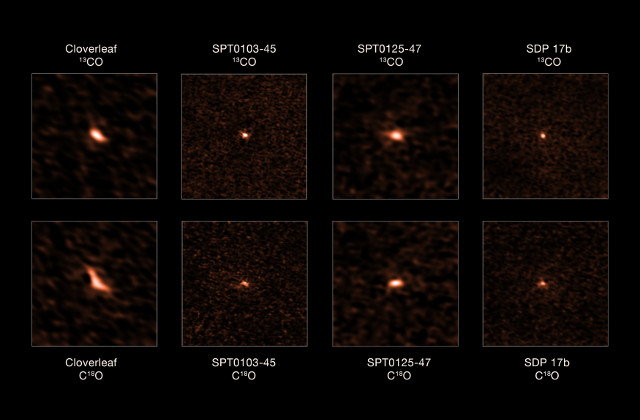
An article published in the journal “Nature” describes the discovery of star formation regions where the percentage of massive stars is much higher compared to others. A team of astronomers led by Zhi-Yu Zhang of the University of Edinburgh used the ALMA radio telescope to study four very old dusty galaxies of the starburst type, meaning where there’s a high star formation rate.
The models about star formation predict that there’s a certain distribution of the mass of the stars that form in galaxies. Even in the galaxies called starbursts, where the rate of formation is very high, the distribution should remain similar but these new observations offered different results by finding an abnormal abundance of massive stars in four very old galaxies.
This study shows the same results as those described in an article published in the beginning of 2018 in the journal “Science” by a team led by Fabian Schneider of the University of Oxford who used ESO’s Very Large Telescope (VLT) to study the Tarantula Nebula. These are all results that contradict current models.
The researchers who observed the early universe using the ALMA (Atacama Large Millimeter/submillimeter Array) radio telescope, inaugurated in March 2013, observed galaxies that appear to us as they were when they were very young. This means that within them there are few star formation events and this avoids confusing results.
Zhi-Yu Zhang and his team developed a technique to measure the abundance of different isotopes present in carbon monoxide in those distant galaxies. Oxygen-18 is an element that is produced above all by massive stars while carbon-13 is produced above all by small and medium mass stars. The identification of the various isotopes allowed to evaluate the mass of stars in very distant galaxies where that kind of estimate is otherwise impossible.
The top image (ALMA (ESO/NAOJ/NRAO), Zhang et al.) shows the starburst galaxies observed with ALMA. At the top there are the emissions from each of them of carbon monoxide with the carbon-13, or 13C, isotope, at the bottom there are the emissions of the molecule with the oxygen-18, or 18O, isotope.
The detection of those isotopes in the observed starburst galaxies showed a ratio between oxygen-18 and carbon-13 about ten times higher compared to galaxies such as the Milky Way. This means that in those galaxies the percentage of massive stars is much higher than expected, just like in the Tarantula Nebula.
This characteristic is not only a scientific curiosity but influences the evolution of the stars’ host galaxies. Their mass is in fact a crucial factor in their lives’ length: massive stars consume their hydrogen at great speed and then die after “only” a few millions of years in supernovae leaving behind black holes and scattering many heavy elements in space. The consequence is that their study is important to understand how planets that form subsequently are “seeded” by those elements and also how there may be black holes “seeds” that perhaps merge to form supermassive black holes that in turn have a huge influence on their host galaxy.


